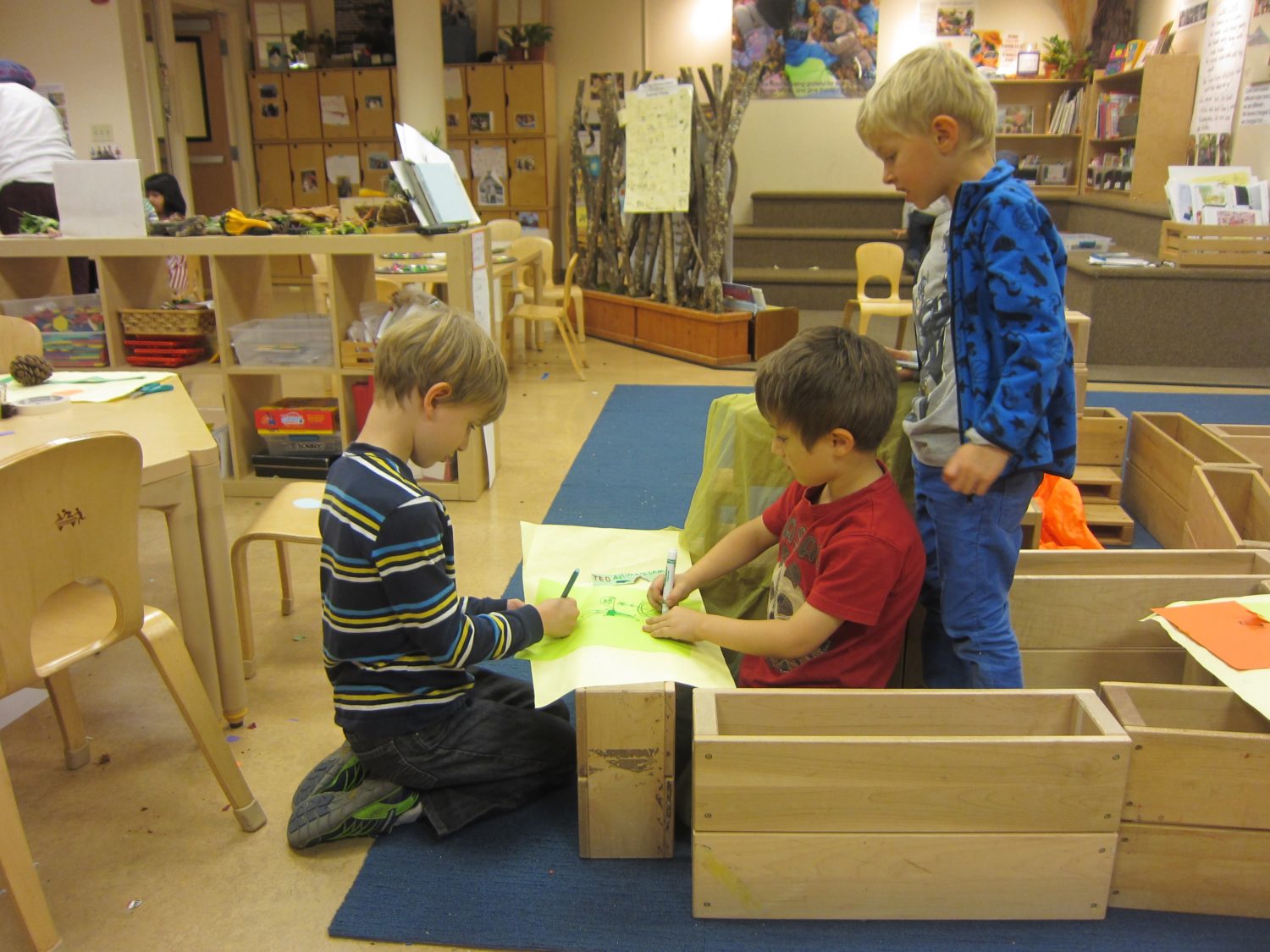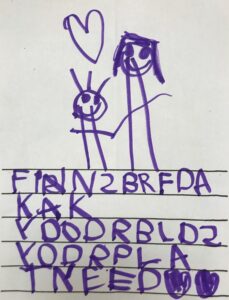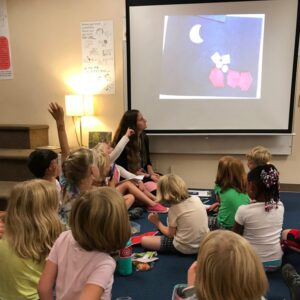Getting Started with Story Workshop

Story Workshop is an approach supporting young children’s literacy built upon on four pillars: the sharing of stories; immersion in the arts; time for play; and a focus on meaning-making. The approach – which has since flowered in schools and districts around the world – started at Opal School with a simple question embraced by our teacher-researchers: What is the connection between literacy and the arts? That question took us from a practice of Writer’s Workshop into new terrain.
Educators interested in Story Workshop often ask us, How do you get started?
And we often answer: It depends.
Which is true. But I’ll share with you a peek into some of the ways in which I’ve observed this year’s kindergarten and first grade class get started. This year, our Cottonwood group of 5-7 year olds are led by two new teachers, Sarah and Kye. Sarah was an apprentice teacher in this classroom last year and Kye is new to Opal School. During these first days of Story Workshop, Sarah has been taking the lead.
Within the very first hour of the very first day, Story Workshop had begun. That’s the kind of central place in our work that Story Workshop has come to be at Opal School. We find it to be that important and that powerful. Also, we know that children come to school full of stories.
On this particular first day of school in this particular classroom, after saying goodbye to parents, gathering in a circle on the floor rug, and saying good morning to each other, it was time for Story Workshop. Sarah began by saying to the children, “I think you probably came to school with stories. Show me the sign for connection if you did.” And she signed “connection” with a nod and a smile. And many signed back. Then she asked the children to take a piece of paper and markers or colored pencils and use them to “create a summer memory” they could share. She let children sit where they wanted to sit, and to help themselves to the markers or pencils, which were arranged on shelves in various places in the room. Kye handed each child a piece of paper when the child was ready and asked for one. And they began.
Some scribbled. Some made lots of dots. Some drew detailed pictures. While the paper had lines for writing, many children turned it over and used the blank side. Though they weren’t asked to do so, many children wrote words.

When children finished and said, “I’m done!”, they were invited to do another. And after about 25 minutes, they were all ready to transition. While they enjoyed a snack together in the gathering area on the rug, Sarah asked who would like to share. Both kindergarteners and first graders shared stories. And Sarah encouraged the other children to ask questions, to offer comments, and to make connections.
There it was. Nothing fancy. Just a simple invitation and readily available, familiar materials. But these simple invitations have profound implications. That is true always, but especially on the first day of kindergarten, in the first hour. Consider the unspoken messages to these children:
I know you have stories to tell.
Your stories will be listened to here.
The things we do in school rely on your stories.
I trust you to make choices.
I am curious about you.
I am ready to meet you where you are.
I expect you to listen to other people’s stories.
I know you will find connections because I know you want to make sense of things.
You belong here.
These messages are intentional, and the experience in the classroom is designed to deliver them. A structure that prioritizes story can do that.
Those of you who bother to ask us how we start Story Workshop in the first place are probably wondering at this point: Yes! But what about the materials? Where are the beautifully organized materials? What about the preparation and introduction of those? And I’ll get to that in a moment, I promise.
But first I want to underscore the story part of Story Workshop. Story Workshop is fundamentally about story. We have learned to rely on story to take us where we want to go. It’s not something that needs to be coerced and it’s not something that – in its most basic form – needs to be taught. This week was the first week of school for our Beginning School students, too. One three-year old boy, new to the school, speaks a few words of English but his first language is Korean. As he played in the blocks with two other boys, they were telling stories about just having moved to Portland. This little boy said, “I move Korea,” which is a story, but not a true story, it turns out. It was an effort to connect — through story.
First we establish an environment that promotes play, because play promotes story and story promotes writing.
When I visited the Cottonwood classroom again, several days into the school year, it was snack time, and the children were gathered with Sarah on the rug, sharing a story a child had written during Story Workshop that day. This time, however, the projection screen was pulled down, and Sarah was showing a photograph of the child’s drawing, an enlargement that supported everyone to see the image much more clearly than they could on paper from all the places they were sitting. This story, and the storyteller, were given prominence.

The child shared, and took a couple of questions or suggestions and then Sarah switched the photo on the screen to a photo of a collage the child had made with loose parts before she had written her story.

Before the children went to work on this day, Sarah introduced loose part collage materials to the whole group during the part of the structure we call, “provocation”. A provocation is sometimes a mini-lesson in the more traditional sense. Sometimes teachers use this time to explore spelling strategies or punctuation or the proper use of staplers. But oftentimes the provocation is an opportunity to offer the children tools to draw out more than they realize they have within them but which we know is there. We find that languages of the arts are the best tools for that. Over the years, children have described the experience by saying things like, “materials are good for finding, and for bringing up your story,” and materials help “wake up stories,” and “materials do have a little surprise inside of them!” Children learn to trust materials to help them figure out what they’re thinking about.
During this provocation, Sarah used the collection of small loose parts to create a movable collage as she thought about and told a story from her own life. When she finished, she invited the children to give it a try. She said, “You might have a story in mind already, like a summer story, that you want to tell through collage, and others might need to play with collage materials to find your story! Both are okay!” She also told them, “We record and capture stories everyday in Story Workshop. I want you to think about how you will record your story today so that you can share it with our community.” This invitation to play also comes along with a stated expectation to capture the story on paper somehow. This is why, when it was time to share, the children had both written stories and photographs of their collages to share with others and to use to reflect on their process.
One of the kindergarteners reflected, “It’s cool to make things that you don’t know what they are. Because after you can think of what it might be and say, ‘Oh! it might be this!’” Once again a child proves able to articulate what we’ve seen time and again: not only do materials wake up stories in children’s minds, they also make it possible to reflect on the process of idea-making itself.
During this first full week of the school year, Sarah introduced paint, another material likely familiar to many of the children, and also shared a mini-lesson on using the alphabet charts available to each child to help them find the letters they would need for the words in their stories. Offering these charts, and designing a mini-lesson to suggest their use communicates the expectation for writing, and provides a tool for those who are ready. Those who are not yet ready, enjoy exposure to something they will make use of when they are.
Reader, are there surprises here for you?
How have you gotten started with Story Workshop this year? We would love to hear about your experiences!
